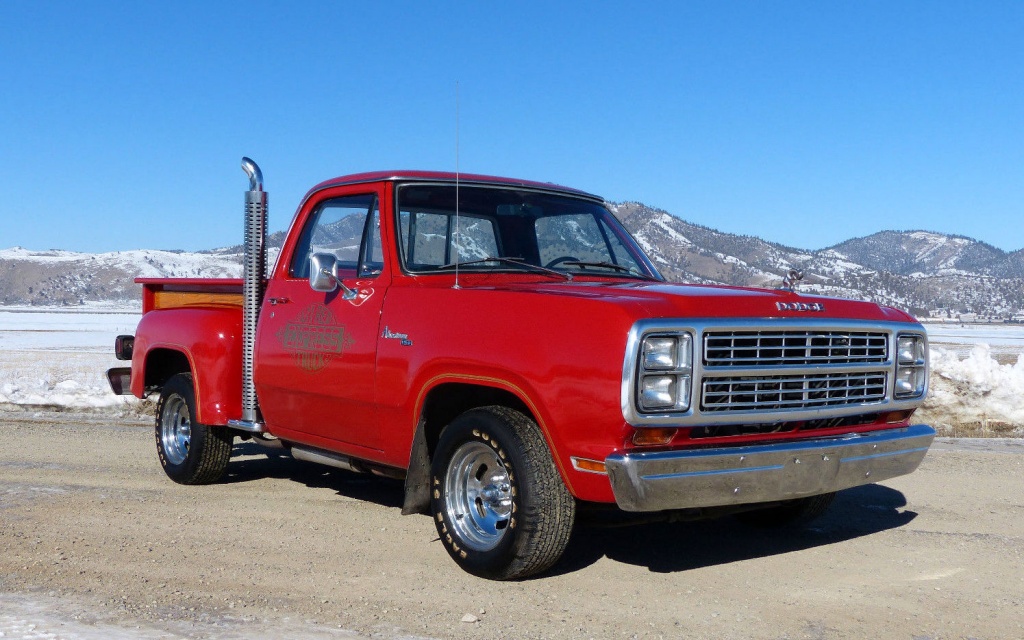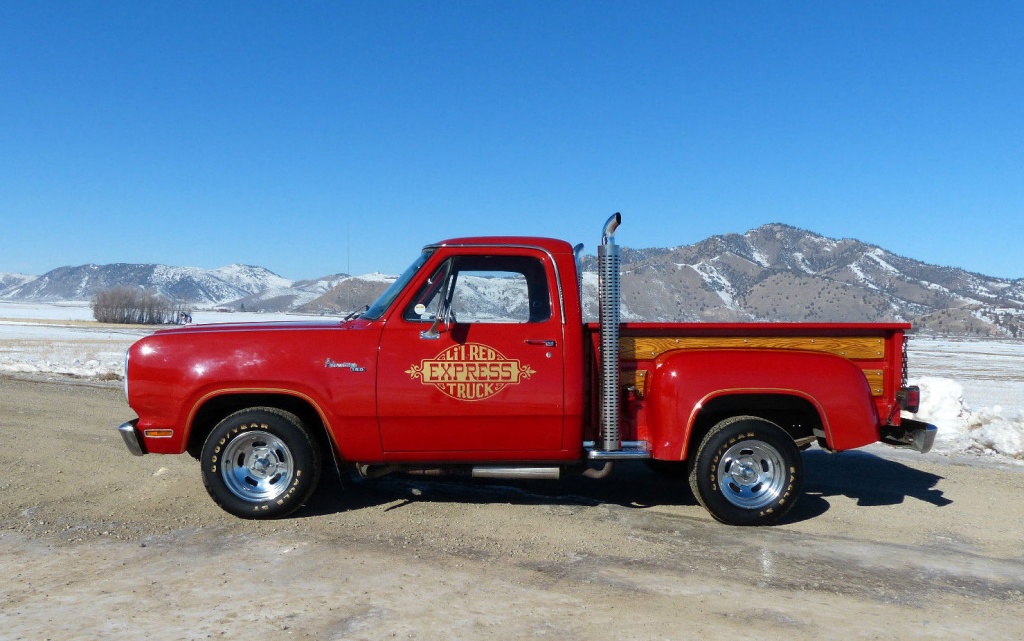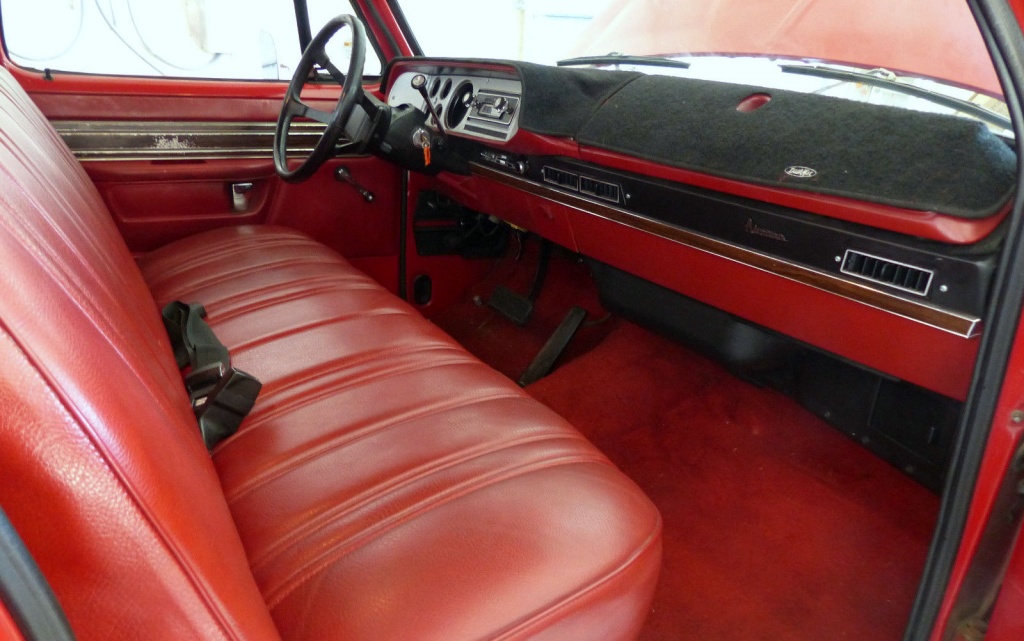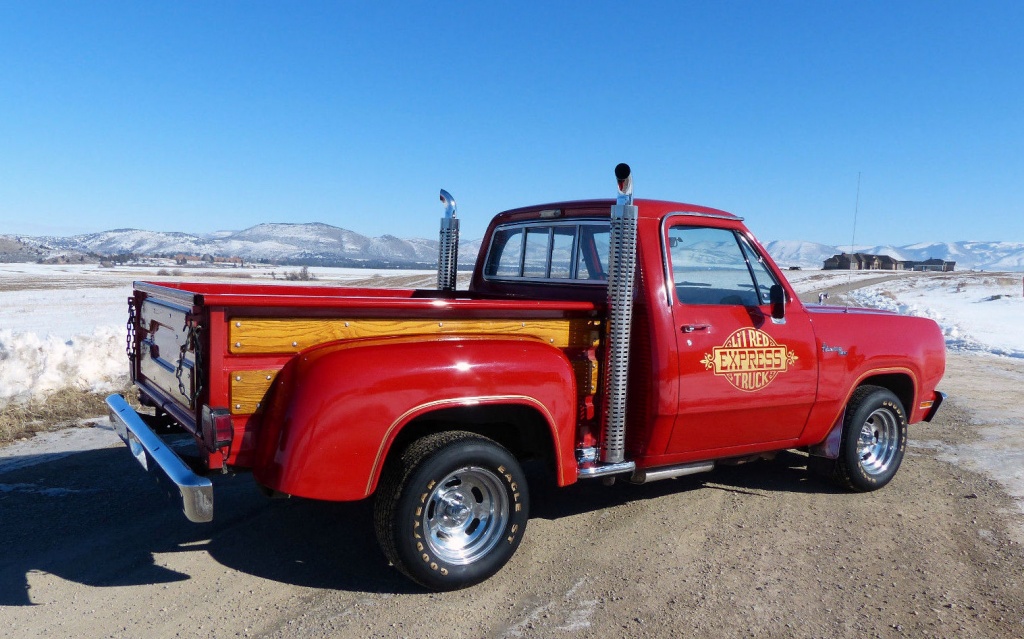If you were to ask the average car guy when the muscle car era ended, they would likely tell you that the days of fire breathing big blocks ended in the mid ’70s. What would you say if we told you that end didn’t really happen until 1979? To really answer that question you have to define what makes a muscle car. Most would agree that it could be any American production vehicle with a high performance engine shoe horned under the hood and perhaps some visual upgrades. Based on that definition, it seems that Dodge’s Li’l Red Express Truck could be considered the last muscle car. It had a tuned V8, visual enhancements, and even suspension upgrades. The one you see here is a survivor and has been in storage for the past 24 years. Find it here on eBay.
I’ve probably just stirred up a beehive of diehard muscle car fans and I’m sure there are a few that would argue a truck can’t really be a muscle car, but before anyone gets upset about semantics, hear me out. The whole idea behind the muscle car was to take a plain production car, one that regular people drove everyday, and make it into something more exciting. Well the Dodge D150 was as regular a vehicle as one could get and a lot of regular people drove them. It would seem to me that the performance tuned 360 cui V8, bright red paint, and high performance tires should added up to some serious fun. You might call it a “Performance truck”, but if you ask me what it is in its most basic terms, I’d say it’s a muscle car.
Alright enough ranting, let’s get down to the Lil Red Dodge’s story. Before the Li’l Red Truck, Dodge had already offered special equipment trucks, but for the most part they had just been visual packages. The Li’l Red was their first foray into the high performance truck world. They took their Police spec V8, changed out the cam, and got rid of the catalytic converter. There was a loophole in regulations that allowed them to get away with not using a catalytic converter, but in ’79 it was closed and they were forced to add one. Power output was 225 horses and 295 pounds of torque, which seems a bit underwhelming given the trucks 3 ton curb weight. Even with all that weight, this truck was the fastest American production vehicle in ’78, beating out the Corvette to 100 mph.
The seller of this truck claims it is completely original and unrestored. There are a few cosmetic issues, but nothing of serious concern. Given how shiny it is, we think it has either been repainted or someone has spent some serious time buffing and polishing. Let’s hope it’s the later and that all that bright red paint really is original as the seller claims. The interior looks correct and shows a few signs of wear, but is in nice overall condition. I’m not sure about living with this bright red interior every day, but it sure looks great in the photos.
To keep everyone happy, I have to concede that a more appropriate title would be “muscle truck”. It really isn’t a car, but in my book it’s definitely the last of an era. It offers just as much flash as any muscle car, it might even be a little over the top, but you have to give it to Dodge for trying to keep the big block alive as best they could. With only 7,000 or so built, there aren’t many left and very few can claim to be this original. Let’s just hope the claim turns out to be true! So do you agree with this being called the last product of the muscle car era or would you say this truck was in a genre all its own?








Not a “muscle car” or “muscle truck”. The muscle era ended with pollution control systems added.
If this were to be considered a “muscle car” then so would be the ’75 Chevy Monza 2+2 with a stock 262 V-8 I had when I was 17. Whopping 110 hp. “Muscle car”…I don’t think so.
“given the trucks 3 ton curb weight” The gross vehicle weight and actual vehicle curb weight are very different. This truck weighs far less than your claims of 3 tons.
Hey Rob, thanks for bringing that to my attention. No one seems to know this trucks actual curb weight, everywhere I’ve looked lists the GVW. Curb weight has to be significantly less than 3 tons, as GVW is weight of the truck fully loaded with cargo and passengers. I’ll keep hunting for the curb weight and if I come across it, I’ll update the post. If anyone here already knows the weight, let me know!
Only weight reference I found was this;
1979 Dodge D150
Total Vehicles: 1
Total Weight: 3576 lbs
Vehicle 1: 1988 Dodge D150
Length: 17 ft 7 in.
Width: 6 ft 8 in.
Height: 5 ft 9 in.
Curb Weight: 3576 lbs
Wheel Base: 10 ft 11 in.
Vehicle Runs: Yes
Convertible: No
Modified: No
Additional Information: this truck is a 1979 model 1/2 ton, it will run and drive but will need to be hauled on a trailer. Report a Violation
Found at;
http://www.uship.com/shipment/1979-Dodge-D150/102640452/
the “shipping weight” is shown on the title.
It ended in the early 70s. I say good riddance as someone who remembers the era. Their performance wasn’t as good as people seem to remember and they were poorly built at best.
If someone wanted to leave it in my driveway i wouldn’t care how they classified it! Always wanted one of those…
Might seem insignificant but the sound of one of those gear reduction starters was too much for me to handle. My Dad bought a brand new 69 Road runner and that car would be my one exception to being bothered by that noise. Otherwise they all remind me of my Grandparents 76 Aspen wagon with that grating starter noise over and over as it never did run very well. Did these express trucks have the same quirky lean burn setups?
I would consider the Lil Red Express a muscle “car” or truck. I’ve always liked the looks of this truck and would love to have one like this in nice shape.
Trucks never did it for me, but these did/ do have a following, we had one of these around the corner for years.I guess it’s kinda cool with the Semi exhaust poking up there.
The writer stretches the definition of a muscle car wide enough to drive a truck through.
In no way is this a muscle anything, period.
There is no muscle present when 360 cubes yields 225 horses.
This is a novelty pickup truck. No shame in that , Enjoy it for what it is and have fun with it.
fast for it’s time. could and were used as trucks/work trucks. a lot were hot rodded also. which is why there are so few left. this would make a real nice daily driver. great find
Dodge did not use the Lean Burn on trucks until 1986. Chrysler cars used it in the late 70’s, and it was a POS. The Little Red Express used a four barrel carb, with the standard for the time, Chrysler electronic ignition. It was pretty reliable. I worked with a fellow who owned one of these trucks. It was more eye-flash than anything else, but was a fun little truck non-the less. Dodge had some interesting options for light trucks in the 70’s. I remember another co-worker who had a 72, maybe a 73 D-150 LWB fleetside with a factory 400 engine, 727 trans and all the goodies. That thing would haul a**! Of course my father owned a 73 F-150 with a 460 and a C-6, so things were different back then. This LRW looks good, and appears to be a nice find!
I would call this a muscle truck for sure. I remember some in my area years ago. I did not think a lot of them because there was a lot of real hot Camaros,mustangs,gto,cudas. That was in the 70,s-80,s. What time for me as a car guy. I still love those cars and own a few. Of these is a 1973 gmc stepside,2whd factory 454 and 12 bolt/4:11 posi, factory tach and a lot more orig. options[only power assist stuff are brakes steering].And yes its faster than my 1968 corvette, and just as fun to drive That’s a muscle truck. a few years later for gm they offered a similer package . gmc named theres a street coupe, chev. called theres a sport coupe . they sold very few of these,i think mostly of cost and gas mileage, my gmc base was less than 4,000, but the final price was like 11,000. quite a truck.
Anyone out there know about these gm trucks? I would love to here from you. Road and track mag. did a write up of a gmc street coupe in the 70,s and called it coupe d rat. neet
One thing to note is that the `78 model Lil’ Red Express came without catalytic converters. This truck, a `79, was required to have them as the EPA caught on to what Dodge was doing with the Lil’ Reds after the first year. The easiest way to tell a `78 apart from a `79 is the `78 has a single round headlight on each side with inboard amber turn signals. The `79 has the dual stacked headlights. Either way this is an extremely cool truck and would look great in any garage.